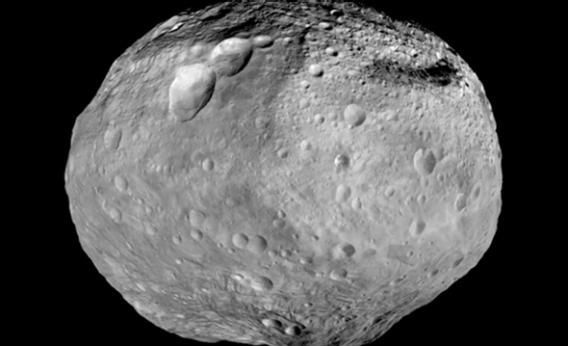Create a free profile to get unlimited access to exclusive videos, sweepstakes, and more!
Why Is Vesta Groovy?

Vesta is a weirdo. Itâs the third-largest asteroid in the solar system but the second most massive. (The asteroid Pallas is somewhat larger but less dense, so it has less mass.) Something as big as Vesta should really be fairly spherical, because its gravity should be strong enough to crush its own shape into a sphere.
But it isnât. It really isnât. Hereâs a picture of the rock put together in 2012, a mosaic assembled from pictures taken by the Dawn spacecraft:
As you can see, a ball it isnât. The south pole, at the bottom, is remarkably flat, with a single towering mountain in the center. This is almost certainly an impact basin, formed when something very large hit Vesta very hard.
Vesta is about 500 kilometers across (300 miles); for a sense of scale, and that mountain at the bottom rises 23 km (14 miles) from the crater floor: over twice as tall as Mt. Everest. The basin is essentially the whole southern hemisphere of Vesta, and the entire asteroid is flattened, oblong, due to that impact.
Now look to the north. See those long, parallel features? Those are grooves, and because they run aligned with the basin, theyâre probably the result of that impact. Hereâs a better shot:
Cracks form in solid rock after an impact, and they do tend to run parallel with the crater rim. But Vestaâs features are different: They donât look like sharp valleys or V-shaped cracks as youâd expect if Vesta were one, big, solid rock. Instead, they look more smoothed, filled in (U-shaped). You can really get a sense of that in this animation made from topographical observations of Vesta:
A study that came out in 2012 looking into this and found that the shape of these grooves indicate Vesta is not a monolithic rock, but is instead layered, possessing a core, a mantle, and a crust!
That sounds more like a planet. Hmmm.
If an object like an asteroid or planet gets big enough when it forms, gravity will pull heavier stuff to the center and lighter stuff will float to the topâthis process is called differentiation, for obvious reasons. Thatâs why Earthâs core is made of dense nickel and iron, while the crust has much lower density rock.
According to the study, Vesta may have done the same thing. When a stiff rock gets impacted the cracks that form are very sharp, but in a differentiated body they tend to be smoother. This is an interesting idea, and the evidence seems to support it. Weâll need more to be sure, but for now scientists have a fun lead to follow.
Unfortunately, the Dawn mission is no longer orbiting Vesta; after more than a year of circling the asteroid it left Vesta behind to visit Ceres, the largest asteroid. Itâll arrive there in 2015. So for now, weâre done getting close-ups of Vesta.
Iâve been thinking about asteroids lately (well, Iâm always thinking about them), and in a few of my recent talks Iâve been asked about Pluto being a planet, so itâs natural to put the two concepts together. Is Vesta a planet? Well, I like to think that the word âplanetâ isnât something you can rigorously define; itâs an idea, a concept. It has fuzzy borders, and rightfully so. Nature rarely paints firm boundaries separating objectsâon the smaller end of the scale, asteroids and comets can suffer the same intrinsic overlap.
If you want to call Vesta a planet, thatâs fine with me, but itâs very much unlike any of the others. Itâs probably better to think of it as we always have: as a very large asteroid with features that are very planet-like. That way, you wonât prejudice yourself either way.
So yeah, Vesta is a weirdo. But you know what? I like weirdos. Why be normal? Being different (differentiated?) is so much more interesting! And it gives us a lot more opportunities to learn.
Hat tip to my pal Corey Powell.


























